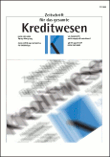Sie befinden sich hier: Home › Kreditwesen › Ergänzende Informationen › Archivdaten › Outlook for Asset Backed Securitization in Germany
Archivdaten
01.09.2007
Aufsätze
Outlook for Asset Backed Securitization in Germany

Dieser Artikel ist Teil unseres Online-Abo Angebots.